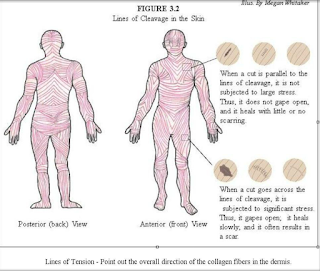Understanding Skin Tension Lines: Langer's and Beyond
 |
| Figure 1: Lines of Cleavage in the Skin - VirtualHomeSchoolGroup.org |
Understanding Skin Tension Lines: Langer's and Beyond
Skin tension lines, commonly referred to as Langer’s lines, are crucial anatomical guides in dermatologic and surgical practice. These lines represent the natural orientation of collagen fibers in the dermis and correspond to the direction that the skin is most resistant to stretching. Making incisions parallel to these lines generally results in better cosmetic outcomes and faster healing, while cuts across them may gape open and scar more visibly [1].
The concept originated with Karl Langer, an Austrian anatomist, who in 1861 used circular incisions in cadavers to map how skin responded to tension. The resulting oval shapes indicated the natural lines of tension in the skin [1].
In clinical practice today, understanding these lines helps optimize surgical planning, particularly for excisional biopsies, plastic surgery, and trauma repairs. Surgeons strive to align incisions along these lines to minimize wound dehiscence and scarring [2].
Biodynamic Excisional Skin Tension (BEST) Lines
Beyond the classic Langer’s lines, more modern approaches such as Biodynamic Excisional Skin Tension (BEST) lines are gaining traction. BEST lines consider not only the static anatomical tension but also dynamic skin movement from muscular contraction and daily activity. These lines vary from patient to patient and can be manually assessed preoperatively by pinching the skin to identify the direction of maximal tension [3].
Incorporating these biodynamic considerations, especially in high-motion areas like joints or the face, can further enhance healing and reduce scar formation.
Surgical Techniques and Suturing Resources
A key aspect of aligning incisions with skin tension lines is ensuring proper wound closure. Resources like Duke University’s Suture Techniques and Skills provide detailed video instruction on various closure methods, including subcuticular, vertical mattress, and running sutures [4]. Another great hands-on option is Skills On Point, which offers both online and in-person suture training courses for healthcare providers [5].
Understanding skin tension lines also benefits wound care specialists and dermatology nurse practitioners, especially when debriding or applying tension-relieving dressings.
Visual and Educational Tools
For visual learners, DermNet NZ offers clear diagrams of skin tension lines across different anatomical areas, which can aid clinical education [6]. Meanwhile, Clinician’s Brief provides practical image galleries and summaries for use in veterinary and human surgical contexts alike [7].
References
-
Wikipedia. Langer's lines. https://en.wikipedia.org/wiki/Langer%27s_lines
-
Medscape. Skin Incisions and Wound Healing. https://emedicine.medscape.com/article/1127307-overview
-
McClellan, D. A., et al. (2013). The Biodynamic Excisional Skin Tension (BEST) Lines: A new surgical approach. ResearchGate
-
Duke University. Suture Techniques and Skills. https://www.surgery.duke.edu/education-and-training/suture-skills
-
Skills On Point. Online and Live Suture Workshops. https://www.skillsonpoint.com
-
DermNet NZ. Skin tension lines illustration. https://dermnetnz.org/imagedetail/15452-skin-tension-lines
-
Clinician’s Brief. Surgical Tension Lines Image Gallery. https://www.cliniciansbrief.com/article/image-gallery-surgical-tension-lines
Comments
Post a Comment